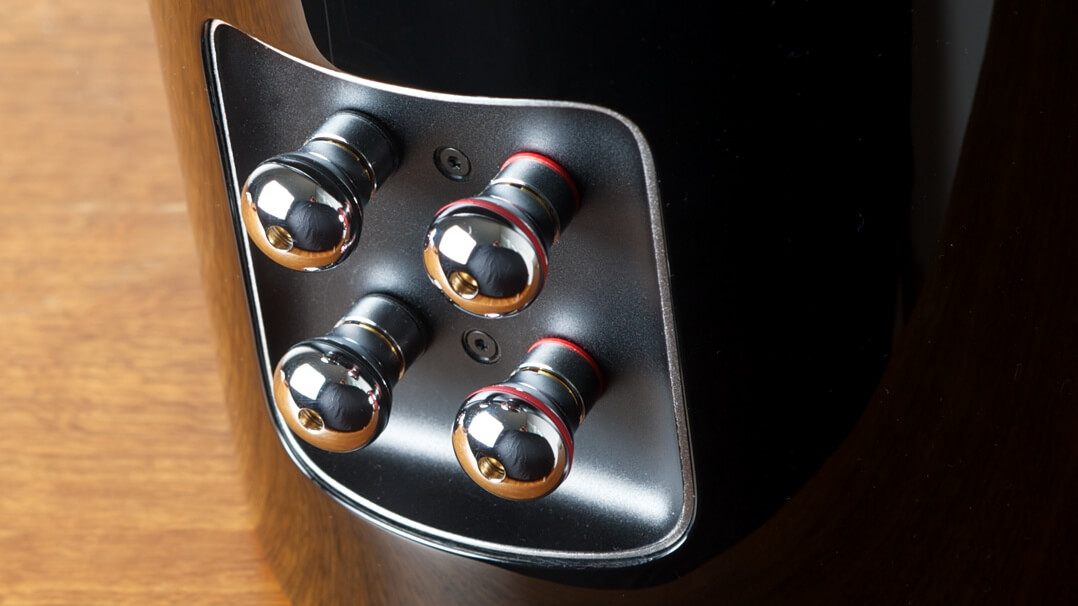B&W 805 D3 Review
The B&W 805 D3 is a stand-mount, bookshelf speaker (1) from Bowers & Wilkins that features the Diamond dome (2) tweeter, isolated in its own aluminum (5) solid-body tweeter assembly (3) as a signature from the manufacturer (4). Ths mid/bass driver is manufactured with proprietary material (6) Continuum (8) and there are four binding posts (10) in the back of the cabinet (9) allowing a bi-wire setup (7).
At first glance, the Bowers & Wilkins B&W 805 D3 is almost recognizable as a B&W. As usual, in this B&W 805 D3, the tweeter sits cheekily on top.
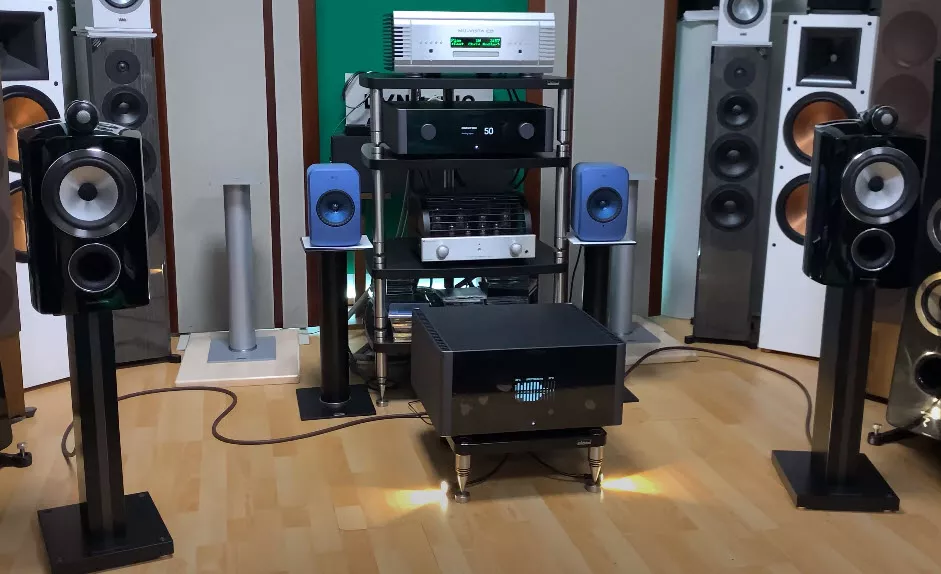
We would like to thank the Audio department at El Corte Ingles for letting us testing and mounting the stands for Santos Redwood, Rosenut, and Gloss Black speakers.
But where did the yellow Kevlar membrane go? Well, either the better half of the developer no longer liked this color, or is there new material for the bass-midrange? Well guessed, there is a new material, the Continuum™ membrane. Fine braided and shiny silver. According to the manufacturer, the development took a proud 8 years! The price for it? 6,000 dollars for the pair of high-end speakers and 1,000 dollars for the stands. What do the compact speakers sound like? More on this in our test.
We have tested the B&W 805 D3 thanks to the Audio department from El Corte Ingles who allowed us to play around with the Gloss Black, Rosenut, and Santos Redwood editions. There are other colors available, such as Satin White, but they were not available at that moment for the showroom. El Corte Inglés also allowed us to mount the Rosenut edition with the stands.
The B&W 805 D3 has quite a few great features, most notably is the signature separate tweeter. It is a 1 inch Diamond Dome tweeter mounted in a solid aluminum housing. The mid/bass driver is a 6.5-inch Continuum™ driver. There are 4 binding posts on the back allowing for a bi-wire set up to get even more detail out of the Bowers & Wilkins B&W 805 D3.
We were very impressed already with the Bowers & Wilkins 804 D3, which played brilliantly in the listening room. Now the much smaller sister model B&W 805 D3 wants to prove that they’re made of the same wood. The following will show us whether these compact speakers can also take us to a higher level of sonic excellence.
Bowers & Wilkins renews its Diamond 800 range, which includes the B&W Diamond 802 D3, B&W Diamond 803 D3, and B&W Diamond 804 D3 column speakers, the B&W Diamond B&W 805 D3 compact speakers, as well as the B&W Diamond HTM1 D3 and B&W Diamond center speakers HTM2 D3.
As their name suggests, these speakers use a diamond in their design, in this case, used to make the domes of each Nautilus- supported tweeter. Remember that the B&W Diamond 800 Series speakers are used by prestigious recording studios, such as the Abbey Road studio in England. Recognized for its extreme rigidity, the diamond offers an exceptional transient regime, minimal distortion, and a spectacular increase in frequencies.
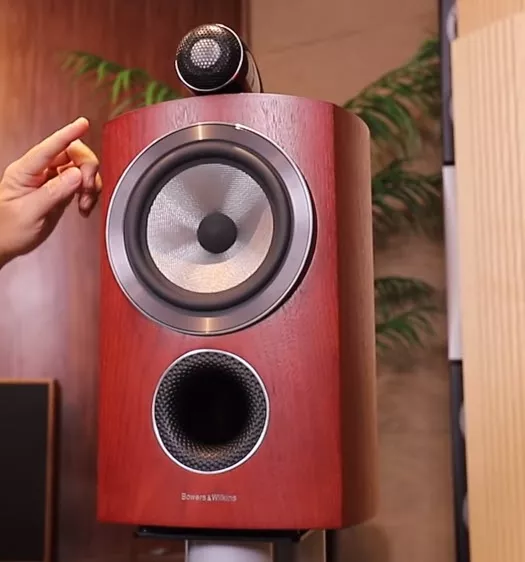
ROSENUT EDITION
Optimal characteristics to design a tweeter, which is fixed to a Nautilus tube, to completely annihilate the stray reflections of the wave deployed backwards.
The B&W 805 D3 has quite a few great features, most notably is the signature separate tweeter. It is a 1 inch Diamond Dome tweeter mounted in a solid aluminum housing.
The mid/bass driver is a 6.5-inch Continuum™ driver.
There are 4 binding posts on the back allowing for a bi-wire set up
The B&W 805 D3 is one of the most interesting members of the family, not least because of the price; here the B&W 805 D3 undercuts the 804 by a whopping 2500 dollars. The processing is not a bit worse than the bigger siblings, and that means a lot. As usual from B&W, the housing is stiffened like a matrix and rounded on the outside. Both promote sound purity. The outer skin has the same first-class piano lacquer, which makes the series visually legendary. Alternatively, cherry and rosewood are available.
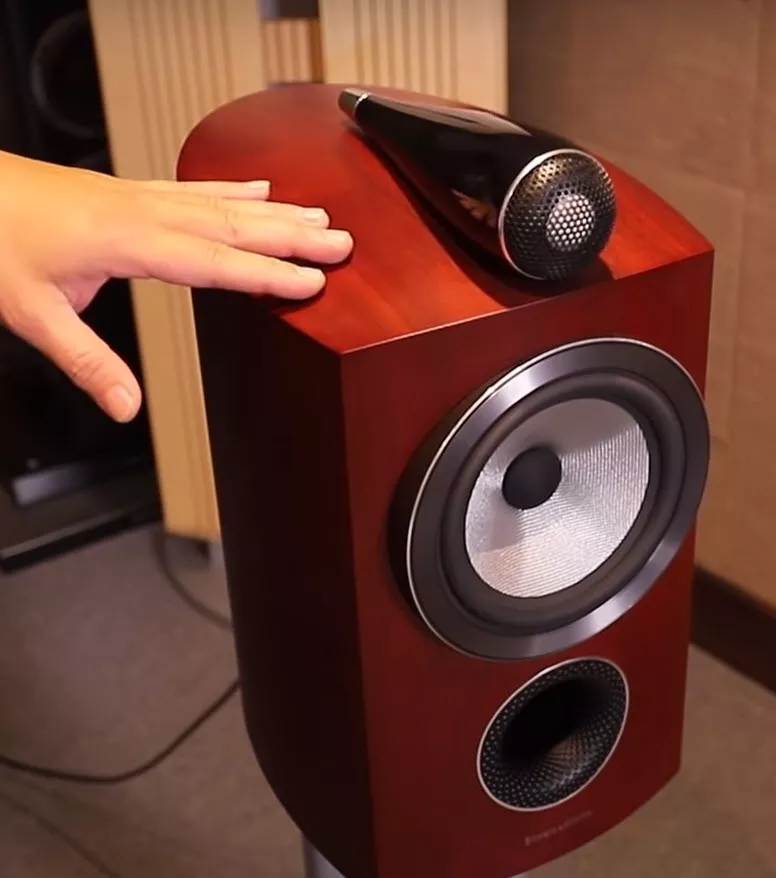
Pros And Cons
Pros And Cons Of The B&W 805 D3
Pros
- Excellent workmanship with a plywood cabinet.
- Best sound possible in its price range-
- Installation, biwiring, mounting of the stand, all can be done easily and in about twenty minutes.
- Cables are all included (forums say that they are not, but we unboxed three devices and they are present, the manufacturer´s scope of delivery also includes them)
Cons
- Quite expensive because you need to count 1000 dollars more for the stand. The stand is necessary because I am aware that the best imaging and best avoidance of soundwave dispersion will be obtained when the tweeters are close to ear height when seated. Tower speakers already solve this problem, but this B&W 805 D3 is a bookshelf speaker
B&W 805 D3 As A Replacement For The B&W 805 D2
In this special test case: B&W 805 D3 replaces – at least in the company catalog – the 805 D2.
The fingers only want to type the phrase “replace” reluctantly: I have been living and listening at home for years (and with never-ending enthusiasm) about the 805 D2, which I always found the bottom line of the 800 series. You can’t just replace a speaker like this. Or is it?
Obviously, many processes have been perfected with the new 800 series. And you can actually see it: Although they are much more difficult to manufacture than the D2 models due to the more pronounced curvature of the baffle, the workmanship and finish have improved considerably. And even the “old” Diamonds from 2010 were not bad parents in this regard.
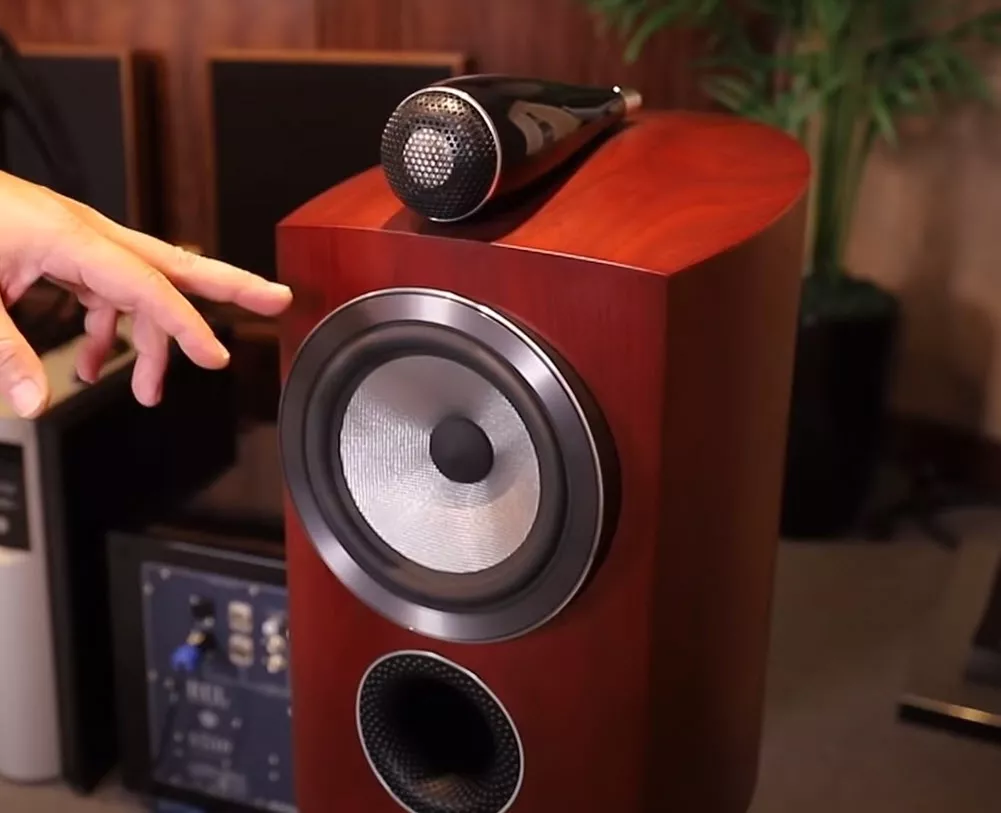
Change Of Materials: Continuum™ instead of Kevlar
Any hi-fi fan who sees the B&W 805 D3 for the first time will immediately know that it is a Bowers & Wilkins speaker. This is despite the fact that B&W has recently dispensed with the yellow Kevlar membrane on the baffle, the most distinctive feature of the British for decades. The fact that the British are throwing the Kevlar diaphragm away, which has been in use since 1974, overboard is the result of many years of research.
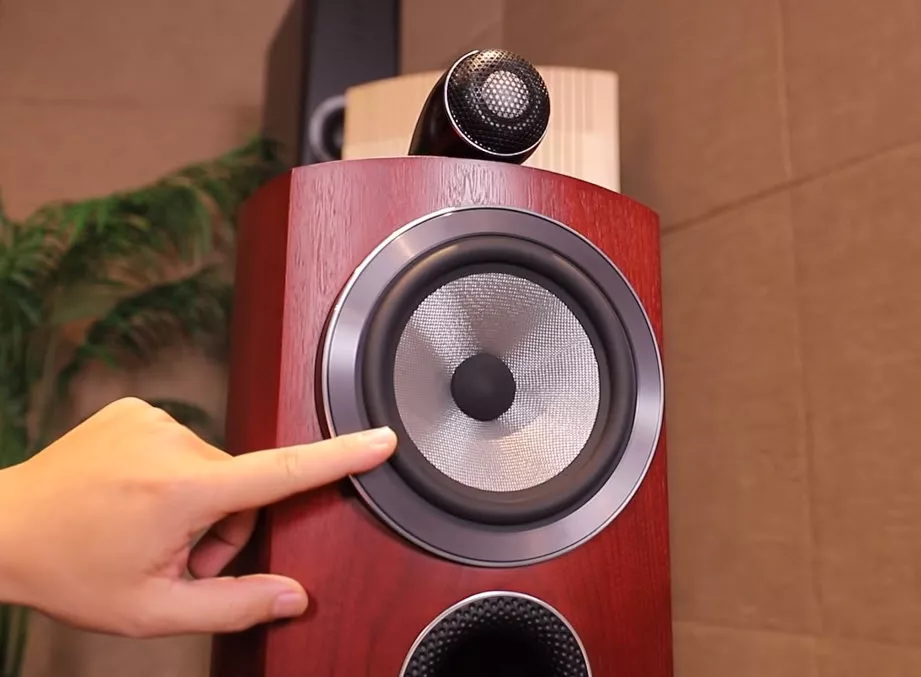
CONTINUUM MATERIAL REPLACED KEVLAR.
B&W has sworn by the use of Kevlar for more than 40 years and has achieved extremely good results. Incidentally, the British hi-fi manufacturer was the first at the time to recognize the advantages of extremely strong Kevlar fibers in loudspeaker construction and to use them for themselves. The situation is different with the B&W 805 D3 compact loudspeaker.
Instead of the typical gold-yellow Kevlar membrane, the silvery shimmering Continuum™ membrane is used. This is coated fabric, The final version, after eight years of research and 70 different versions, represents a major development in driver production. If Kevlar has been used for decades because of its extremely high strength, this new material can hardly be surpassed in terms of stiffness.
Eight years ago the developers set about the arduous task of creating an even better material for the bass and mid-range diaphragms. Their main concern was to find the “perfect” structure and geometry for their loudspeaker drivers. It took them a long time, but now the new diaphragm material with the desired properties has arrived – the Continuum™ diaphragm.
All-new speakers in the 800-D3 model series are equipped with this silvery shimmering braided membrane, which, according to their own statements, has clearly exceeded the developers’ boldest expectations.
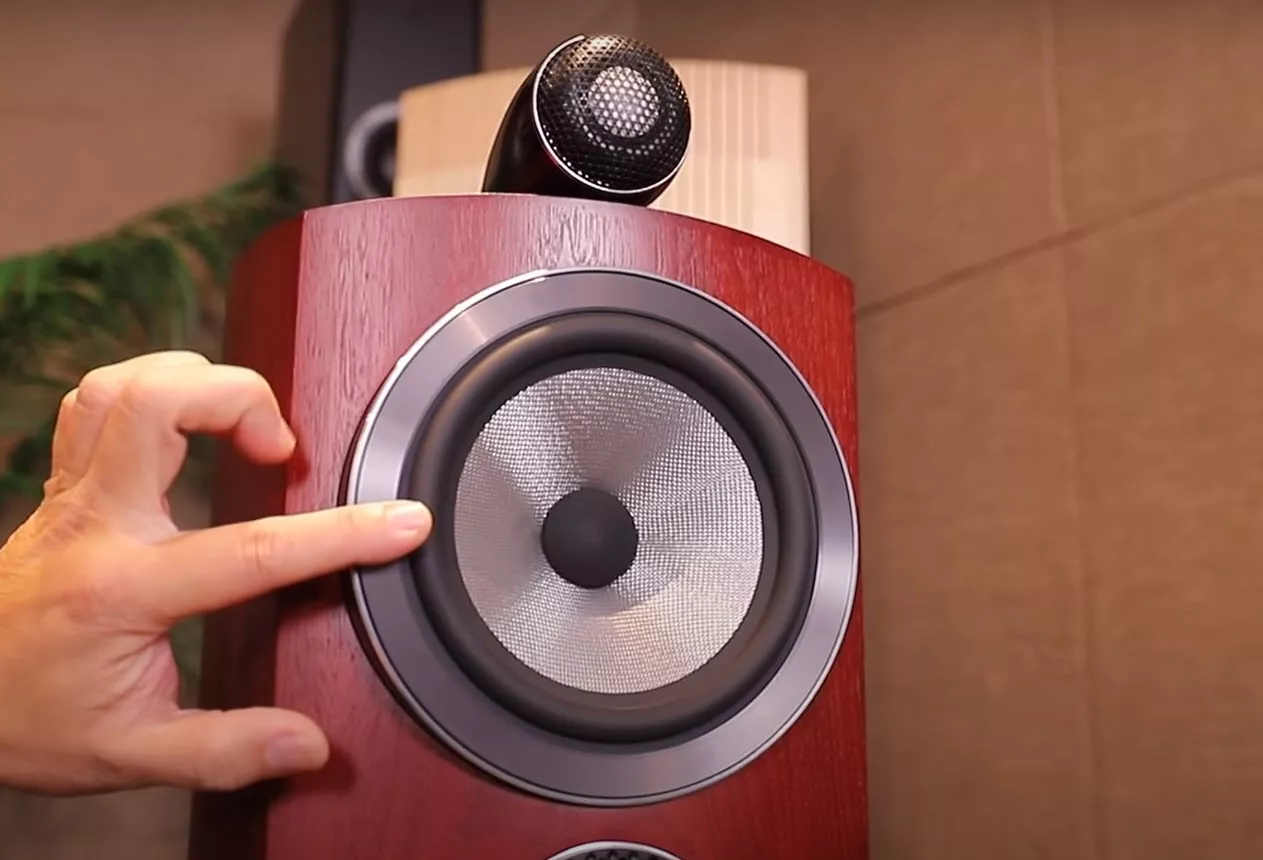
Similar to the Kevlar used by B&W for many years, the “Continuum™” material – a stable, coated fabric – has a woven structure. But, it should be less resonant than Kevlar and have better internal damping. Careful touching of the membrane confirms this: it feels soft, stable, “full”. In contrast to normal dust caps, the anti-resonance plug sits firmly in the voice coil former. It should not only minimize resonances but also lower the breakup frequency of the membrane, which should have a positive effect on the richness of detail of the sound – so it says at Bowers & Wilkins.
In fact, the departure from Kevlar in the 800 flagship line documents a kind of turning point that the cheaper series will also follow in the foreseeable future. With all the advantages that Kevlar has offered over the years, the striking yellow material not only polarized optically.
The new material, which by the way looks very similar to Kevlar’s structure, is much softer, so it has a much greater internal damping and thus promises a much more neutral reproduction.
This material is virtually tearproof but so soft that I would not have thought that it could be used to build membranes for hi-fi speakers – especially not in the low-frequency range: the B&W 805 D3 uses the silver-gray Continuum™ in the bass.
But of course, the differences between the two lines are not limited to the differences in the cone material. In fact, the B&W developers left no stone unturned in the new 800 D3 series.
Externally, the following applies: the new 805 is roughly the same size as the old one, but looks smaller and significantly more elegant – not only because of the more subtle cone color. And the smallest 800 is now also available in a subtle white.
The manufacturer promises an even spread of the sound, whereby the vibrations should not even reach the edge of the membrane. The method of controlled breaking open continues to be used. This is what it is all about: An ideal low- or mid-range driver is of such high strength that the movements of the magnet driver can be translated one-to-one into air vibrations across the entire surface of the membrane.
Now there is no material that knows how to withstand these requirements. Therefore, a membrane is inevitably “broken open”, so it deforms according to its own resonance frequency. However, Bowers & Wilkins membranes are processed in a way that does not fight against this “breaking open”, but instead causes resonance vibrations, to largely reduce tonal distortions and distortions. And the result is obviously brilliant and precise to hear.
The low midrange driver made of a Continuum™ membrane is a commendable achievement
Ergonomics And Workmanship
I was immediately impressed by the superb workmanship and the design: subtle gray drivers instead of the Kevlar membranes, which for me are always somewhat yellowed. Black piano lacquer applied in an exemplary manner, the complete absence from the edges or screw connections that disturb the view – instead, seamless adjustments of the driver and bass reflex tube but also the construction with the tweeter placed on the top edge of the housing, which was given special storage on a layer of synthetic gel.
The local dealer also supplied us with the loudspeaker stands (that we discuss well below in a dedicated chapter) specially tailored to this model (plus 1,000 dollars), which – using a cordless screwdriver – can be assembled in less than 15 minutes, and due to the precisely fitting holes and meticulous manufacture of the load-bearing elements by an assembled state absolutely perfect stability. Also commendable: B&W includes high-quality cable bridges with every pair of 805 D3s.
The housing of the Bowers & Wilkins B&W 805 D3 is not made from inexpensive MDF, but from curved plywood, which always results in stable housing. In addition, there are some stiffeners inside, so nothing moves except the low-frequency sound.
The bass-midrange driver has a diameter of 16.5 cm, which is surrounded by a fat surround, and thus enables decent strokes. Beneath the bass-midrange is the “Flowport bass reflex”, which is now well known by B&W. The bass reflex tube has recesses similar to a golf ball so that there is no turbulence due to the air currents.
Those who liked the previous models of the 800 series will be pleased that the newcomers will stick to the proven concept of the series. The absence of straight outer walls and sharp edges not only gives the case an elegant appearance but also promises additional rigidity. This is also supported by the interior wall cascades familiar from B&W. The turbine head, in which the chassis of the notorious diamond dome tweeter is retained as an eye-catcher by the new generation.
The authentic housing made of solid aluminum is mounted on the rounded top of the speaker as with the previous models. The dome inside the turbine is decoupled from surrounding components by a gel system.
The slightly curved tweeter does not consist of one piece of the valuable material but is vapor-deposited in a very complex process in wafer-thin layers.
The workmanship and feel quality make a really excellent impression. The Bowers & Wilkins B&W 805 D3 is available in elegant black and white high-gloss lacquer, and there is also a real reddish walnut veneer. On the back there is a high-quality BiWiring terminal, cable bridges are included for the connection.
Bi-wiring
Let´s consider also bi-wiring (The bi-wiring principle is simple: Instead of one speaker cable, two are routed to each box. One cable is connected to the terminal for the bass range, the other to that for the mid/high range. The improved sound is not only attributed to the lower ohmic resistance (the cable cross-section doubles yes) but above all to the reduction in electromagnetic interactions)
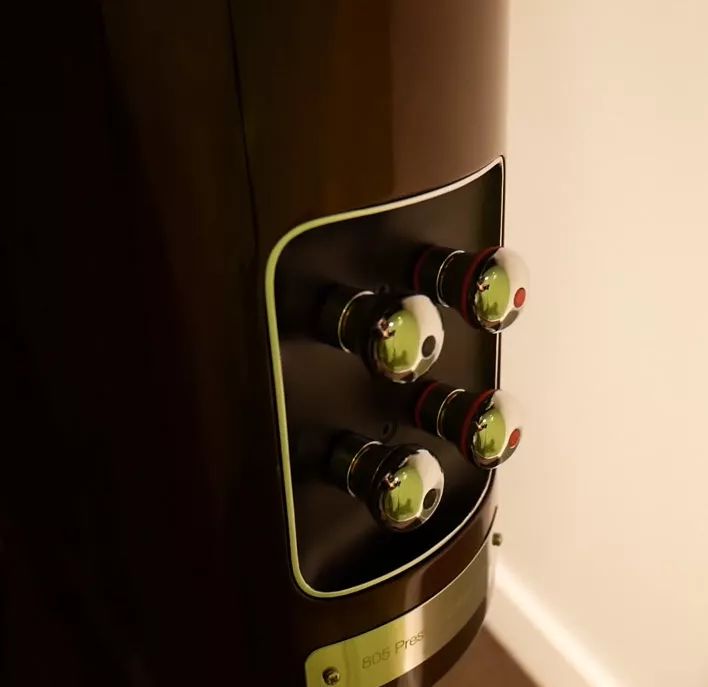
There are 4 binding posts on the back allowing for a bi-wire set up to get even more detail out of the Bowers & Wilkins B&W 805 D3.
The Bowers & Wilkins B&W 805 D3 bi-wiring terminal. The supplied cable bridges for single-wiring operation are not shown in the picture
Conceptually, the B&W 805 D3 is a two-way bass-reflex compact loudspeaker with a bass reflex opening radiating towards the front. The bass-midrange is a classic cone speaker (165 mm) with a “Continuum™ membrane” and an anti-resonance plug.
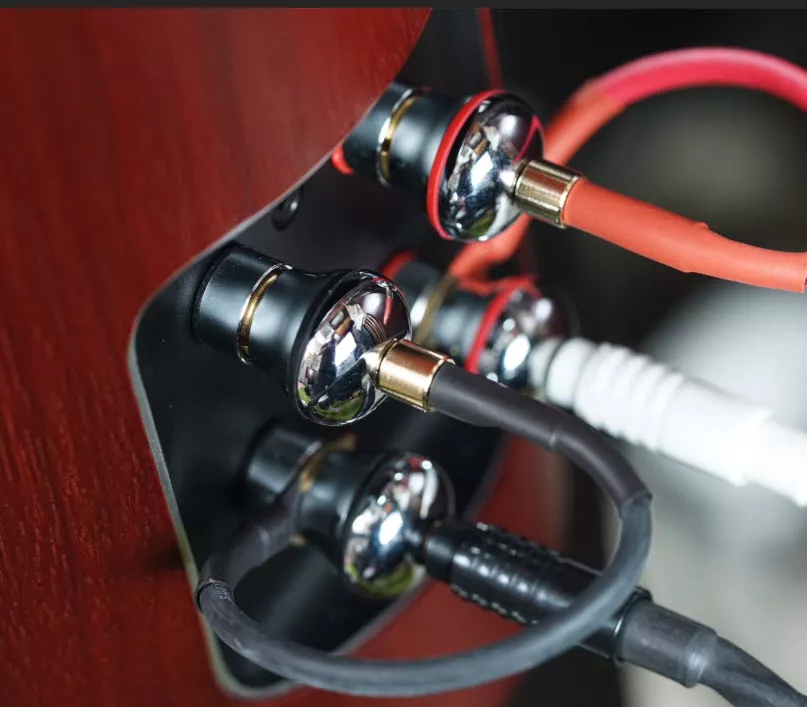
The “Flowport bass reflex tube” sits below the bass-midrange. Its surface has a roughened structure that is reminiscent of a golf ball. This also has a method: In this way, turbulence and flow noise from the airflow is to be reduced.
A look inside the loudspeaker is worthwhile: The cabinet is stiffened by a sturdy plywood frame – at B&W which is called “Matrix” – in which precisely fitted acoustic foam blocks provide additional damping. The internal wiring is carefully covered so that it does not move even in the case of “high drafts” inside the cabinet.
Construction
The 165 mm format bass-midrange driver vibrates in a long-stroke surround that, in combination with the powerful drive unit, enables it to achieve enormous dynamics. To ensure that the invested energy does not dissipate uncontrollably, the B&W developers have given their smallest speaker in the 800 series a massively braced cabinet.
The well-known sophisticated matrix stiffening has been improved once again for the current generation: fewer stiffening elements are used, in return, these have become considerably more stable, as the British now use plywood (instead of laminated wood or MDF).
On the front below the bass-midrange driver the generously dimensioned “Flowport Bass Reflex Tube” opens out, its surface being structured like a golf ball. Airflow turbulences are reduced, i.e. flow noise is minimized and the correct functioning of the bass reflex ports is ensured even at high sound pressure levels.
What you don’t see, but still has to be mentioned, is the excellent quality inside. The slide show may give a very good impression.
The 17-centimeter bass-midrange is held in place with eight threaded screws, the birch multiplex housing is effectively stiffened with the multiple struts of the matrix skeleton. Nothing rattles here.
This structure provides incredible internal bracing ensuring that the sound we hear is produced by the drivers and not influenced by the cabinet. The cabinet construction consists of layers of wood ply with metal reinforcement. This construction teamed with the curve of the cabinet makes for an incredibly rigid platform for the bass mid-range driver to operate.
As already mentioned, it took about eight years before the Continuum™ Membrane was ready for use. Countless laser analyses and listening tests were necessary to form the desired properties.
The result was a finely woven braided membrane whose structure is still somewhat reminiscent of the Kevlar membrane that was used for many years. In the center of the current driver is a dust cap whose surface feels velvety soft. The diaphragm material is generally also quite soft, but of course stiff enough to follow audio signals precisely. At different loads and levels, the Continuum™ diaphragm oscillates very evenly across the entire cross-section.
The Woofer
The woofer of 805 bears a cone diaphragm , which is controlled by a very range-friendly rubber surround. This is where the compact box differs from its bigger siblings, where a chassis that is similar in its core hardly needs any lifting work thanks to a separate woofer and can, therefore, be equipped with a kind of foam brake instead of a dedicated edge suspension.
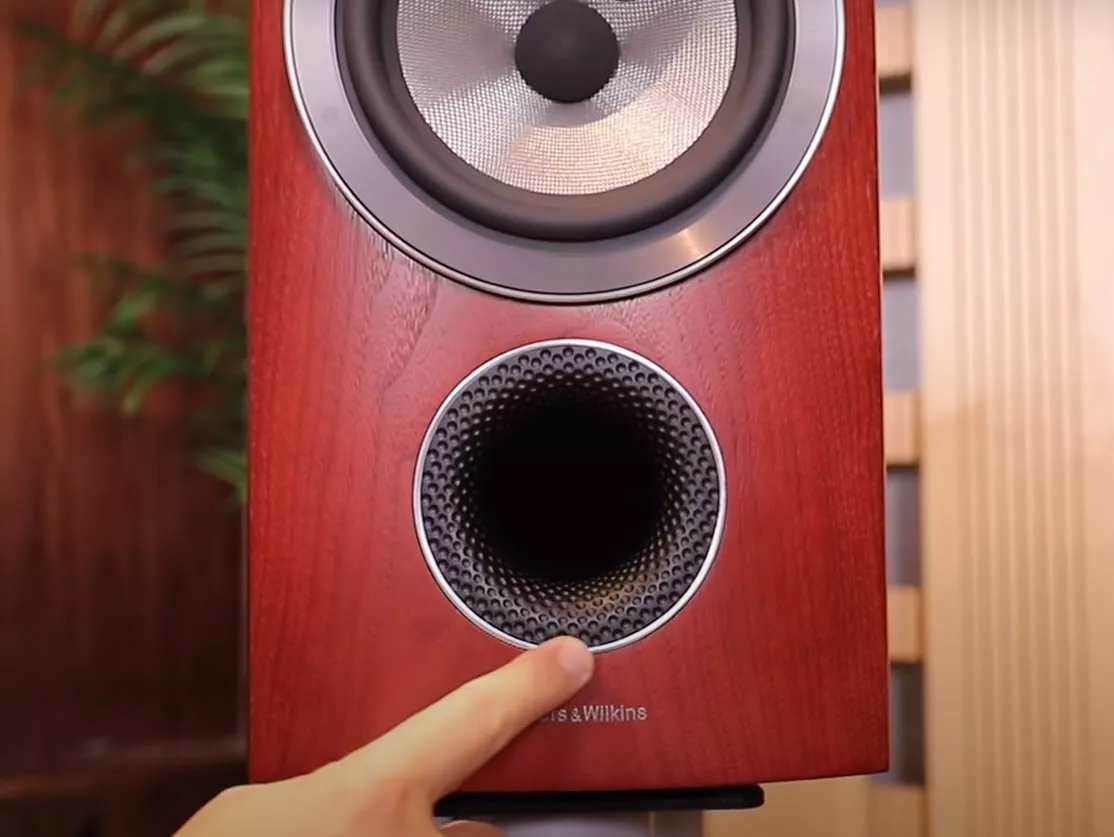
Diamond tweeter
The tweeter part of the B&W 805 D3 is provided by the excellent diamond dome tweeter, a design developed by B&W a few years ago. Refined again and again over the years, the 25 mm dome tweeter now plays far beyond the listening limit before the critical membrane resonances begin. Not only has the dome itself been reworked.
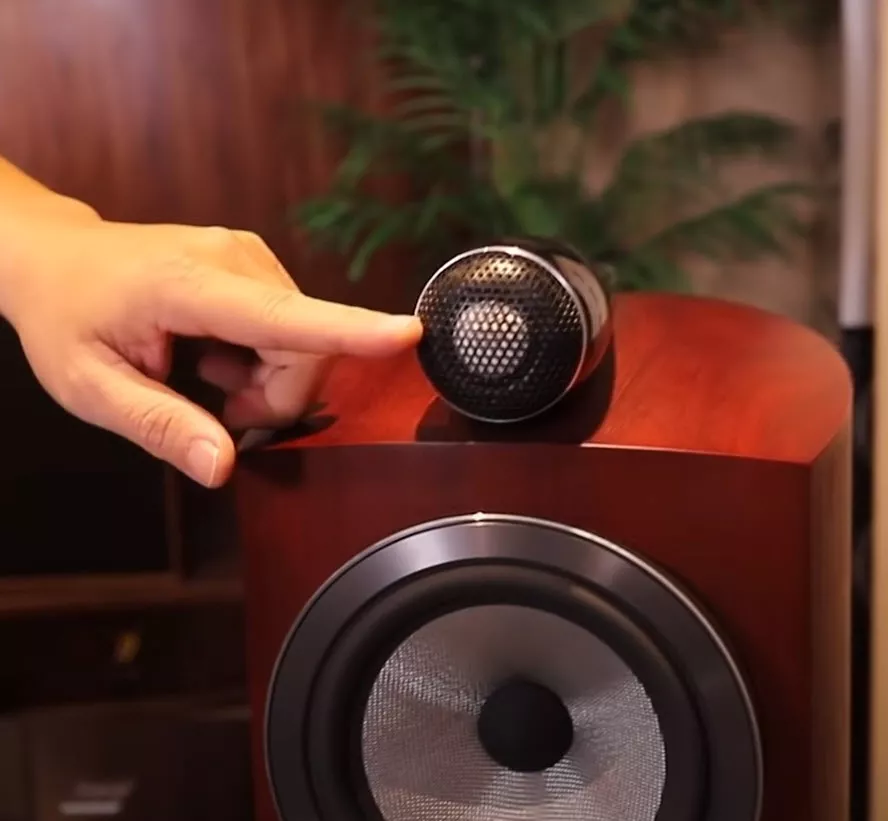 The entire tweeter system has been optimized for maximum efficiency, in which heat dissipation also plays a significant role. The tweeter housing is now made of solid aluminum, an effective heat conductor.
The entire tweeter system has been optimized for maximum efficiency, in which heat dissipation also plays a significant role. The tweeter housing is now made of solid aluminum, an effective heat conductor.
The drive unit finds an ideal place on the loudspeaker body – separated from it by a vibration-reducing gel system. Selected components, among others from the specialist Mundorf, ensure the interaction of the two drivers. The B&W 805 D3 is available in black gloss, matt white lacquer cabinets, and as a real wood veneered version with red walnut. Bowers & Wilkins offers pure perfection, the speakers look fantastic and are superbly crafted.
The diamond dome tweeter is encased in a solid aluminum body and just like the predecessors to the B&W 805 D3, it has that unmistakable look with the tweeter separated and situated on top of the cabinet. This separates it from the main cabinet allowing for a spacious and lifelike reproduction of the music.
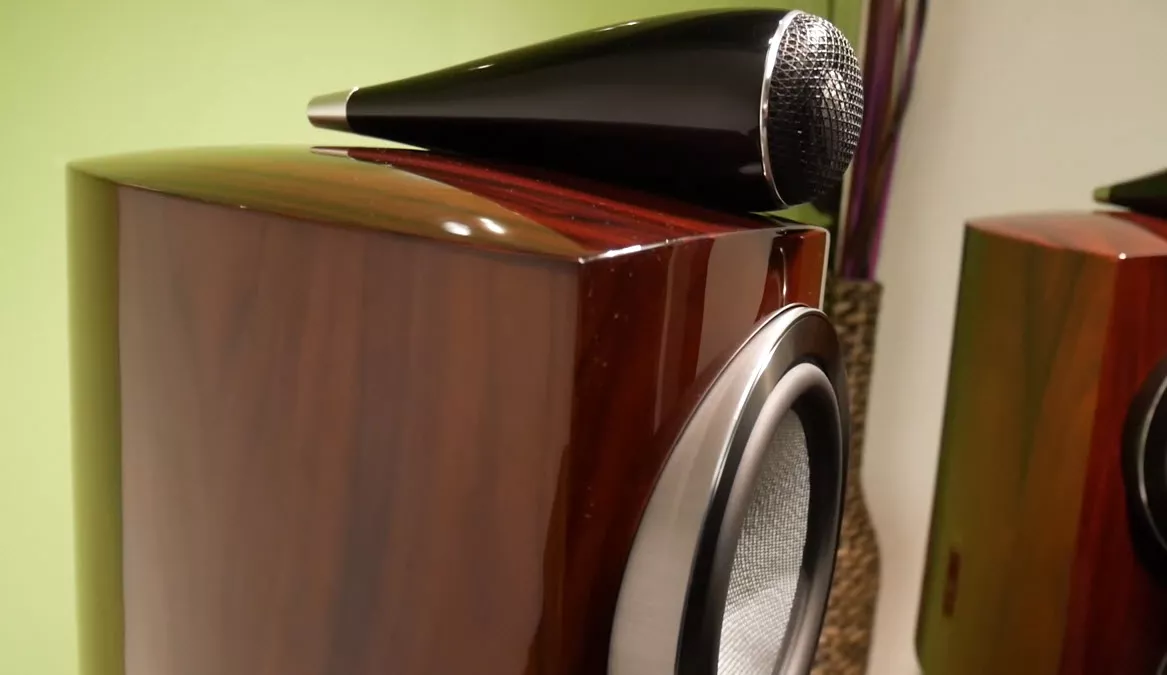
In the high tones of the B&W 805 D3, the diamond dome developed by Bowers & Wilkins over many years comes into play. The metal tweeter resonates above the listening area and does not offend the ear of the listener. The tweeter sits in a conically shaped aluminum tube that allows the rear sound components of the metal dome to run out with low resonance. The tweeter housing itself is decoupled by a gel cushion on the loudspeaker housing.
The hallmark of the 800 series: the diamond dome built into the turbine housing, which can also be found in other B&W loudspeakers
The tweeter is a 25 mm diamond dome, which – as already mentioned – is attached above the loudspeaker in its own streamlined tapered housing. The tweeter is protected from cabinet resonance due to its hermit existence, which should minimize sound discoloration – and the curved lines of the cabinet should not only avoid standing waves inside the cabinet and thus discoloration, but also ensure a uniform radiation behavior without disturbing edge reflections. Little was changed in the high-frequency range, at least I thought. As with the predecessor, the tweeter “hovers” in a tube above the actual housing – only attached to two damped brackets.
The B&W developers couldn’t find a better replacement for the diamond dome that they have been using since 2005. The stiffness and the large transmission range up to approximately 70,000 Hertz of these domes (artificially bred by the De Beer diamond dynasty) is unique.
You can also see it on the market: In the most expensive and best-exposed loudspeakers in the world, there are often diamond domes – mostly tweeters from Accuton. But they are almost prohibitively expensive.
Therefore, despite the price increase from 4,500 to 6,000 dollars/pair, the new B&W 805 is still the cheapest entry into the fine world of the diamond tweeter range.
But despite the same dome, it is no longer the same tweeter. A more powerful drive was developed for the B&W 805 D3, the distortion decreased and the coupled, elongated Nautilus tube, in which the rear sound should run dead, was optimized; it is now a bit more voluminous and made of full aluminum.
The clearest indication of the changes in the high-frequency range is shown by the measurements below.
First, the previous D2 model
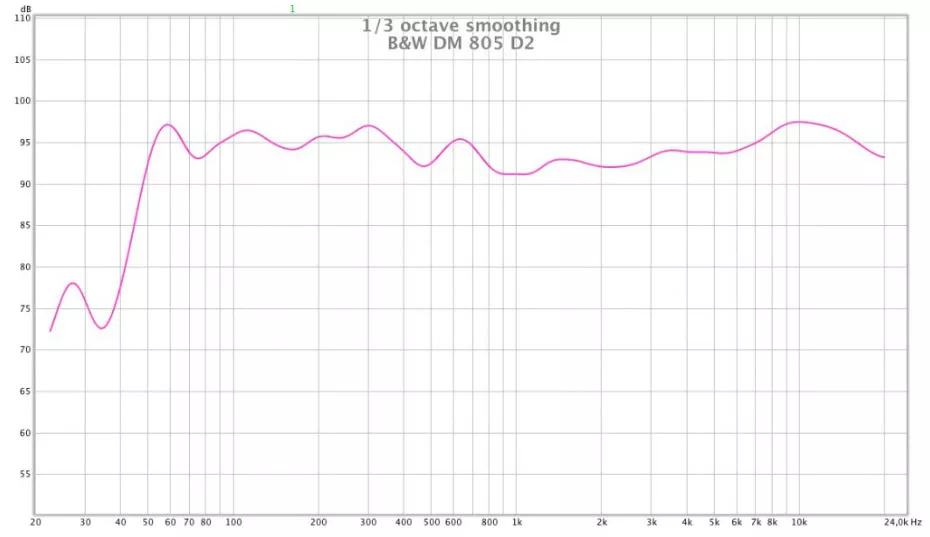
The frequency response of the B&W 805 D2. It is fairly balanced
And now the new one
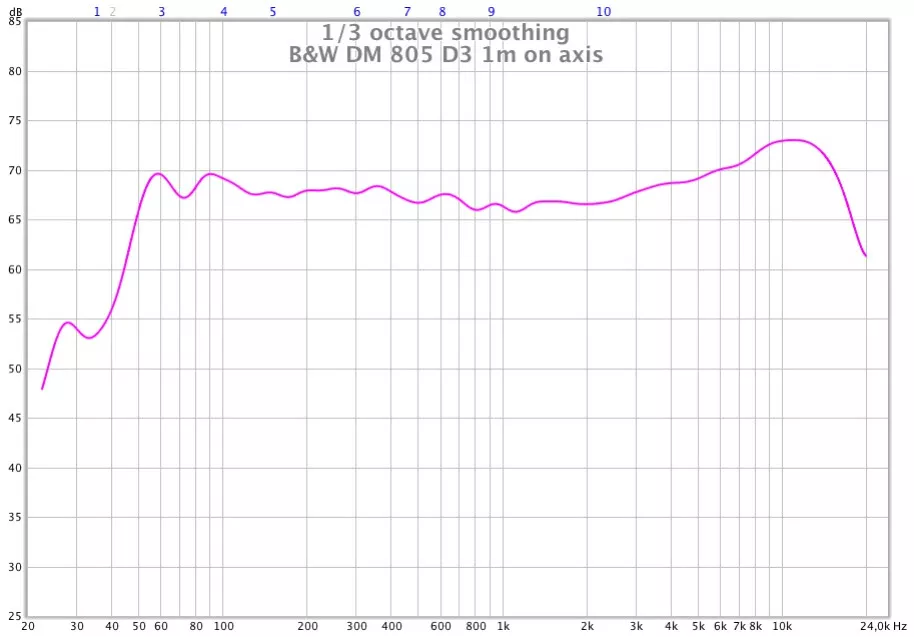
The frequency response of the B&W 805 D3. The gentle increase from 3,000 Hertz of about 3 dB is clearly recognizable compared to the D2
Measurement 1 shows the frequency curve of the predecessor 805 D2: It is fairly balanced, measurement 2 shows the frequency curve of the B&W 805 D3. It increases by about 3 decibels from 2,500 Hertz – you can hear that. This is the best way to see the new tonal direction.
Audio Quality
The speaker is connected to our reference amplifier in no time at all. A banana plug is easily attached to the solid bi-wiring-Terminal connected.
In the listening room, we set up the B&W 805 D3 in a classic stereo triangle and turn it slightly towards the listening position – that way, with a listening distance of just under three meters (10 ft), it fits very well.
Even with the first few bars of music, the compact loudspeakers make it clear that they are masters of their craft. They play fantastically homogeneously, the sound is almost completely detached from the speakers – voices and instruments are naturally present in the room.
For the B&W 805 D3, we used Octave V80 SE reference amplifier We always have a large number of speakers – of course also compact speakers – for testing in the listening room.
If you compare them with the Dynaudio Excite X 18, KEF LS 50, or the Teufel Definition 3, which admittedly play in lower leagues in terms of price. But this was immediately audible: the B&W 805 D3 surpassed them by a long way.
This point, in particular, was surprising to me – as already mentioned – how B&W manages to conjure up such a crisp low tone with this soft Continuum™ membrane.
With the new 800 series, connoisseurs have to readjust their usual standards in terms of level and deep bass capabilities, because here long-standing experience values have been shifted for the better. The 805 already achieves a lower cut-off frequency of 47 Hertz and masters volumes in the three-digit decibel range.
Our test subject withstands the rabid roar without grumbling. Here, the legendary diamond dome is the ideal high-frequency driver. The dome only begins to break open at 70 kilohertz (kHz) (ordinary aluminum dome only reaches 38 kHz) and thus drives the occurrence of unwanted interfering frequencies far out of the human hearing spectrum. Even in the lower realms, tonal components remain clearly differentiable.
Impedance And Analysis
Despite the compact design, B&W specifies a frequency response measured on the axis of 42 Hz to 28 kHz (max. 3 dB deviation) for the B&W 805 D3. With a sensitivity of 88 dB / W / m and an impedance of 8 ohms, the loudspeaker is a rather average “user”, but should also be able to be operated on amplifiers that are not quite as potent. Bowers & Wilkins recommends a minimum amplifier output of 50 watts for safety reasons.
The 16.5 cm bass-midrange speaker of the B&W Diamond 802 D3 speaker has a Continuum™ membrane. Its excellent mechanical behavior during high amplitude sound variations guarantees very high fidelity in the transcription of the audio signal. Thanks to him, the B&W Diamond B&W 805 D3 speaker responds in frequency from 42 Hz to 28 kHz, with a sensitivity of 88 dB. Its low impedance being 4.6 ohms in the low-frequency register, a powerful and flexible amplifier is necessary for its optimal operation.
The new B&W 805 D3 loudspeakers have shown excellent results. The amplitude response is a bit unsteady, like the larger twin model, but here the ears of the developers prevail against the measuring microphone. Ultra-linear frequency response doesn’t necessarily have to sound good. All in all, the system’s enormous broadband capability is convincing. From below 50 Hertz, the compact speaker is in its element and plays beyond our measurement limits. The radiation pattern is excellent, even below 15 and 30 degrees the amplitude response hardly drops below the 0-degree line. There is only good to report about the distortion, especially the k3 value, which has to be critically reviewed, is sensationally low.
Crossover Analysis
The task of the crossover in loudspeakers is to divide the incoming electrical music signal into different audio frequency ranges and to supply these ranges to individual drivers.
Chassis (high, medium, low-frequency drivers) optimized for special frequency ranges can be used, which not only promotes the thermal/electrical capacity of a loudspeaker but also ensures that the individual chassis are allocated exactly the work area that they are assigned to they can process minimal distortion and discoloration.
In addition to this pure distribution function, crossovers also have the task of coordinating the different efficiencies of the drivers used, taking targeted action against undesirable resonances, or compensating for special acoustic characteristics of the housing.
With that said, The crossover frequency of 4 kHz is above average for a two-way vehicle – how does this happen? Well, due to its structure, the diaphragm material of the bass-midrange driver has the property that the sound-emitting surface decreases with increasing frequency.
At four kHz, the sound-radiating surface is reduced to an inner circle of 50 mm in diameter because wave peaks and valleys arise at the edge areas of the membrane that cancel each other out. That means we can generate low and comparatively high frequencies at the same time with this chassis, without these having a negative impact on one another. The tweeter, in turn, is designed in such a way that it conforms perfectly to the crossover frequency of four kHz.
Stand FS B&W 805 D3
An ideal complement to these speakers is the elegant FS B&W 805 D3 stand, which lifts the B&W 805 D3 tweeters to ear level. The integrated cable routing makes the supply lines disappear optically. Firmly screwed to the base, the B&W 805 D3 can be perfectly aligned with the listening position. Four decoupling rubber feet are screwed into the base plates, alternatively, solid metal spikes are available. The base feet are available at a pair price of 1,000 dollars
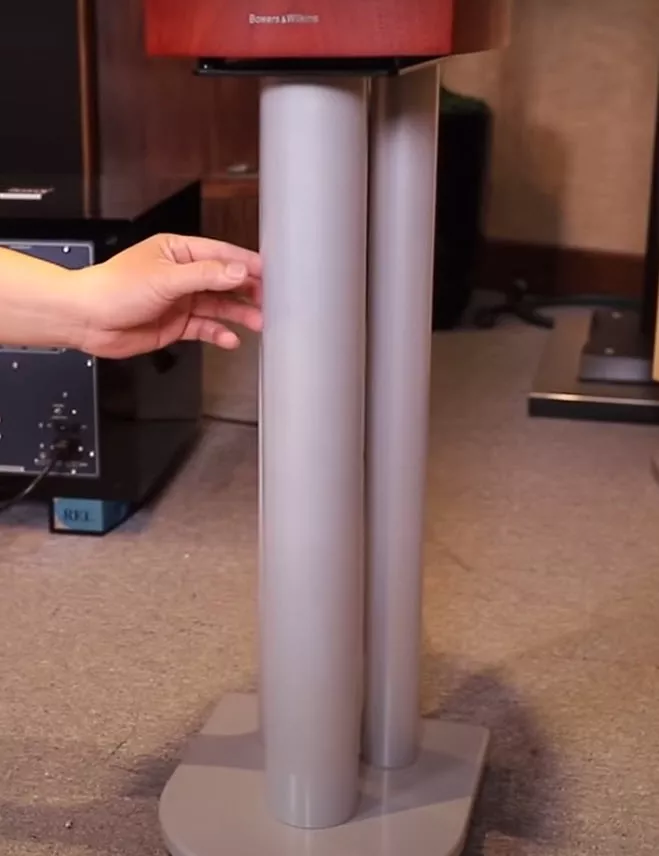
The stand is specially tailored to this model (plus 1,000 dollars), which – using a cordless screwdriver – can be assembled in less than 15 minutes (in the AUdio sector of El Corte Inglés, it took us about 20) and due to the precisely fitting holes and meticulous manufacture of the load-bearing elements by an assembled state absolutely perfect stability.
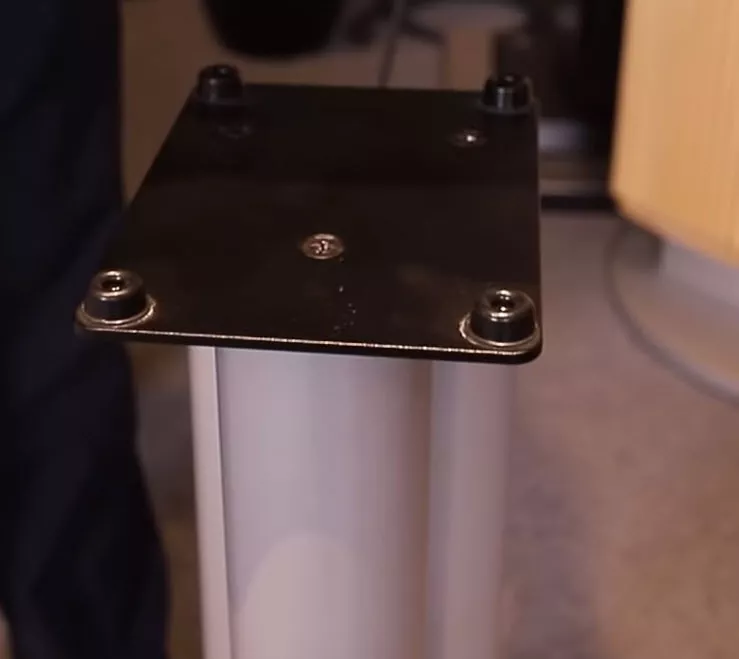
Conclusion: Is The B&W 805 D3 For 5,000 Dollars Worth It?
In fact, the proud, 6,000 dollars B&W 805 D3 compact speaker from B&W is not exactly affordable for everyone. However, the “little one” of the family is already a whopping 3,000 dollars cheaper than its big brother, the 804-floor standing loudspeaker. And if you are considering a slightly larger investment in terms of sound transducers, you are very well advised with the B&W 805 D3!
In addition to the optics that characterize the series, you will find a tried and tested the concept in an optimized form. The diamond dome, which already has a comprehensible influence on the pricing, in cooperation with the bass-midrange speaker from a newly developed Continuum™ membrane gives the speaker an outstanding sonic performance, which rightly gives him studio competence.
Across the board, the B&W 805 D3 knows how to master every genre even at high volume. Even as the “nestling” of the new generation of the 800 Series Diamond, this loudspeaker has no reason to stand behind its siblings. Bowers & Wilkins has undoubtedly succeeded in creating a small masterpiece.
On the plus side of the B&W, 805 D3 is above all a high-frequency reproduction that I have never experienced in this quality at this price. This fine resolution, this clarity, this openness is definitely addictive. Overall, the B&W 805 D3 are loudspeakers that are fun and suitable as a monitor due to their detailed reproduction – especially when it comes to detecting errors in the overtone area. Dynamic dynamism and a large, deep, well-lit stereo stage are further plus points that this converter has for me. Only in the middle band can you get more colors and resolution elsewhere for the money. Overall, the Bowers & Wilkins B&W 805 D3 is a loudspeaker that can convince from small classics to quite crisp rock music.
The workmanship is fantastic and in terms of sound, any compact box in this price range should have a damn hard time getting at this authenticity, transparency, and joy of playing.
Bowers & Wilkins’ 805 D3s are superb speakers that bring music to life in the listening room. As always, the workmanship is of the finest quality and B&W’s technology is state-of-the-art. On their feet, the fine sound furniture enhances every listening room. The superb sound of the new 805s makes these models the touchstone for all other compact class loudspeakers – at least we have found our new reference!
However, one thing must be said clearly: the B&W 805 D3 is clearly brighter than its predecessor; this is certainly not an advantage in “bright” and reverberant rooms. But it also sounds much more open, energetic, passionate, lively, ultimately authentic; you can hear the advantages of the new membrane material.
I mean, despite the impressive price increase, the new 805 is again the top recommendation for discerning music listeners who don’t have that much space.
-
- Legendary finely resolved and well-differentiated high-frequency reproduction, which does not lose any of its accuracies even at high levels. The quite noticeable presence of the tweeter area can be a bit too much of a good thing if it is angled directly into the listening position – in this case, a modified setup is recommended, in which both speakers are parallel to each other and the tweeters aim a bit at the listener’s ear.
- The middle band is “okay”, but does not come up with the same quality and resolution as the high-frequency reproduction.
- The bass reproduction is dry, contoured, nimble – a small upper bass hump cleverly deceives you about locking off the lowest octaves.
- Fine and coarse dynamics are excellent. In this loudspeaker, nothing sticks on the way from the amplification to the ear.
- The nature of the stereophonic stage is extremely versatile and can be influenced by a specific setup. It is striking that the B&W 805 D3 can also be very far apart without a center hole. As the base width of the list increases, the perceived base width seems to increase almost exponentially.
- Special mention should be made of the superb workmanship, the high quality of the materials, and the cable bridges supplied.
Specifications For The B&W 805 D3
These are some of the specifications that we consider are important to know about.
- Modell: Bowers & Wilkins B&W 805 D3
- Concept: two-way bass reflex speaker with dedicated tweeter chamber and bass reflex opening at the front
- Diamond tweeter
- Continuum™™ cone bass mid
- Anti-resonance plug
- Flowport™
- Optimized Matrix
- Solid-body tweeter
- Tweeter-on-Top
- Description
2-way vented-box system - Drive units
1x ø25mm (1 in) Diamond dome high-frequency
1x ø165mm (6.5 in) Continuum™™ cone bass midrange - Frequency range
34Hz to 35kHz - Frequency response (+/-3dB from reference axis)
42Hz to 28kHz - Sensitivity (1m on-axis at 2.83Vrms)
Nominal impedance (min)
8Ω (minimum 4.6Ω)
Recommended amplifier power
50W – 120W into 8Ω on unclipped program
Max. recommended cable impedance
0.1Ω
Dimensions
Height: 424mm
Width: 238mm
Depth: 345mm
Net weight
12.6kg (28lb)
Cabinet finishings
Gloss black
Satin white
Rosenut
Prestige (Santos Redwood)
Further Readings
We have some other interesting articles for you to read, we have selected our top articles below, and tried to keep this list short.
We have a technical vademecum where we discuss industry terminology and how it can be useful for you. Selected examples are the definition of PCM audio, then comes the comparison between PCM and Bitstream, the comparison between DTS Neo 2.5 and Dolby Digital, and the process to match amplifiers to speakers.
Also, we have reviewed some interesting DAC: The Elgar Plus from dCS, and the Schiit stack. where the Modi 3 behaves as an entry-level DAC.
In our reviews of AV receivers, we can recommend you to read some of our favorites, the ones that we liked the most, and trying to make the list short, we have the Denon AVR-X2500H, the Onkyo TX-NR686. We also have reviewed completely the Denon 8K receivers where we have studied the 8K Denon AVR-X2700H, the Denon AVC-X6700H, the AVC-X4700H, and the AVC-X3700H.
If you are into amplifiers, my favorite is the McIntosh MA9000, and that is why I would like to recommend you to read that review. My second favorite amplifier is the Mark Levinson 5805.
Regarding speakers, we have reviewed tiny bookshelf-speaker devices to large towers. My favorites were: the Devialet Gold, the Devialet Silver, the ProAc Response DT8, the Bowers and Wilkins 805 D3,
We do not review many headphones, but if you want a Sennheiser headphone for less than 100 dollars, we have this Sennheiser HD595 review.
We have some TV and monitor reviews and here we recommend the Samsung NU8000 (for gamers!) and my favorite is the review of the classical Pioneer Kuro.
Our home theater aficionados want to know everything about video definitions and configurations. So we studied 720p, how to scale it to 1080p the right way, and compared 1080p with 1440p and demonstrated why 1440p is not always better. Likewise, we had the urge to compare 1440k with 4K and try to find out how much are we gaining with the change.

I am Bob. I work as an audio engineer and audio technician. I work in mastering and arranging bridges in existing songs and the arrangement and orchestration of the chorus. In Planet HiFi I test gear for a couple of days and write a review. I also write about AV topics, amplifiers, speakers, and headphones.

